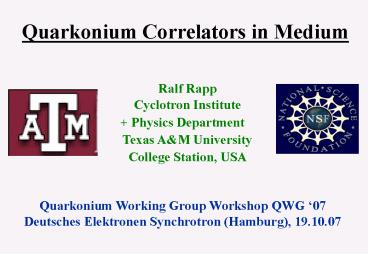Quarkonium Correlators in Medium - PowerPoint PPT Presentation
Title:
Quarkonium Correlators in Medium
Description:
2.3 Uncertainties in Potential HQ Mass. 3.) T-Matrix Approach. 3.1 Baseline Results ... (links to lattice QCD) 4.) Suppression Regeneration in Heavy-Ion Collisions ... – PowerPoint PPT presentation
Number of Views:27
Avg rating:3.0/5.0
Title: Quarkonium Correlators in Medium
1
Quarkonium Correlators in Medium
Ralf Rapp Cyclotron Institute Physics
Department Texas AM University College
Station, USA Quarkonium Working Group Workshop
QWG 07 Deutsches Elektronen Synchrotron
(Hamburg), 19.10.07
2
1.) Introduction Quarkonia Probing the QGP
- immerse -pair into the QGP
- ? Vacuum properties change
- color screening (reduced binding)
- dissociation reactions (and reverse!)
- heavy-quark mass (? mass, decay rates,
threshold)
- Experiment Heavy-Ion Collisions
- yields no access to spectral shape (?)
- mass ? equilibrium number exp(-M/T)
- pT-spectra, v2(pT)
Theory - in-medium -spectral functions
- Euclidean correlators lattice
QCD ? effective models
3
Outline
1.) Introduction 2.) Potential Models
Spectral Functions 2.1 SFs Correlators,
Lattice Results 2.2 Potential Models
(Schrödinger/T-Matrix) 2.3 Uncertainties in
Potential HQ Mass 3.) T-Matrix Approach
3.1 Baseline Results 3.2 In-Medium HQ Masses
3.3 Width Effects 4.) Charmonia at RHIC 5.)
Summary Outlook
4
2.1 Euclidean Correlator Timelike Spectral
Function
Early Example Dileptons (r, w)
integrate
Wetzorke et al 01
RR 01
- schematic at the time
5
2.1.2 Lattice QCD Computations G / Grecon SFs
- accurate data from lattice QCD
hc
cc
Datta et al 04
- S-wave charmonia little changed to 2Tc, P-wave
signal enhanced(!) - similar in other lQCD studies Iida et al 06,
Jakovac et al 07, Aarts et al 07
6
2.2 Potential-Model Approaches for Spectral Fcts.
s/w2
- Schrödinger Eq. for bound
- state free continuum
- sy(w) Fy2 d(w - my ) w2 Q(w -Ethr) fythr
- - improved for rescattering
J/y
Shuryak et al 04, Wong 05, Alberico et al 05,
MocsyPetreczky 05
Y
cont.
w
Mocsy et al 06, Laine 07, Wong et al 07,
Alberico et al 07
Ethr
- Lippmann-Schwinger-Eq.
- for
MannarelliRR 05,CabreraRR 06
- 2-quasi-particle propagator - boundscatt.
states, nonperturbative threshold effects (large!)
- Correlator
LS,P
7
2.3.1 Uncertainties I Lattice QCD-based
Potentials
- free vs. internal energy F1 (rT) U1(rT)
T S(rT)
- (much) smaller binding for
- V1F1 , V1 (1-a) U1 a F1
CabreraRR 06 PetreczkyPetrov04
Wong 05 Kaczmarek et al 03
8
2.3.2 Uncertainties II Heavy-Quark Masses in the
QGP
- quarkonium mass my 2mc - eB
- asymptotic energies F8 U8 - TS8
U8
Kaczmarek Zantow 05
F8
- close to Tc - increasing heavy-quark mass?!
- - entropy contribution?
9
3.) T-Matrix Approach
3.1 Baseline Results 3.2 In-Medium HQ Masses
3.3 Width Effects
CabreraRR 06
10
3.1 Baseline Results V1U1, mc1.7GeV fix, Gy
small, Grec Gvac
hc
cc
- slightly overbound at 1.1Tc
- (or mc too small)
- dissolves at gt2.5Tc
- quickly dissolves above Tc
11
3.2 T-Matrix with in-medium mc - I
- lattice U1-potential, mc from U1 subtraction
hc
- upward shift due to large mc at 1.1Tc
- stable my2mc-eB above ? correlator within 20
12
3.2.2 T-Matrix with in-medium mc - II
- lattice U1-potential, adjust mc close to Tc
zero modes S-Waves
CabreraRR in prep
T-Matrix Approach
Aarts et al. 07
Lattice QCD
J/y
hc
- fair agreement!
13
3.2.3 T-Matrix with in-medium mc - II
- lattice U1-potential, adjust mc close to Tc
zero modes P-Waves
Cabrera RR in prep
T-Matrix Approach
Aarts et al. 07
Lattice QCD
cc0
cc1
- fair agreement!
14
3.2.4 Temperature Dependence of Charm-Quark Mass
- significant deviation only close to Tc
15
3.3 Finite-Width Effects
- c-quark width in propagator
- dominant process depends on eB
J/y Lifetime
GrandchampRR 01
16
4.) Observables at RHIC Centrality pT Spectra
- updated predictions including 3-momentum
dependencies
X.Zhao RR in prep
- balance direct - regenerated
- sensitive to mc , Ncc
17
5.) Summary
- potential models useful tool to interpret
finite-T lQCD - importance of nonperturbative threshold effects
- consistency of boundscatt. states mc
mandatory (T-matrix) - significant uncertainties (U1 vs. F1 , mc)
- S-wave charmonia survival to 2-3Tc in line with
lQCD correlators - no conclusive interpretation yet
- threshold reduction compensates decreasing
binding - quarkonium lifetimes of tY 1fm/c possibly
relevant
18
4.) Suppression Regeneration in Heavy-Ion
Collisions
- 3-Stage Dissociation nuclear (pre-eq) --
QGP -- HG - Stot exp-snuc r L
exp-GQGP tQGP exp-GHG tHG - Regeneration in QGP HG
- - microscopically backward reaction (detailed
balance!)
- snuc(SPS) 4.5mb - RHIC d-Au data ? snuc
0-3mb
PBM etal 01, Gorenstein etal 02,Thews etal
01, GrandchampRR 01, Ko etal 02, Cassing etal
03
- for thermal c-quarks and gluons
19
3.3.2 Observables II Excitation Function
Rapidity
J/y Suppression vs. Regeneration
Sequential Y cc Suppression
Grandchamp RR 01
Karsch,KharzeevSatz 06
- direct J/y essentially survive
- (even at RHIC)
- nontrivial flat dependence
- similar interplay in rapidity!?
- (need accurate dNc/dy)































